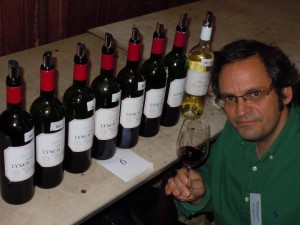Lynch Bages excels in 10-vintage vertical: 16 June 2012, London
June 19, 2012
Generously, seriously Pauillac: ten vintages of Chateau Lynch Bages
It came as no surprise to me that a master class organized by Decanter Magazine at London’s Landmark hotel for Chateau Lynch Bages was fully booked.
Participant Guillaume Raffy, who works for an Argentine winery, remarked after the 10-vintage vertical: “Lynch Bages is one of the best ambassadors of Bordeaux: classic in style, they seem to get it just right.”
Indeed. The wide variety of vintages tasted, from the famous 1990 to the lesser-known 1999, proved once again why this estate – affectionately known as Lunch Bags – is so popular.
Named after his great grandfather – who had purchased the estate in the Depression era, but worked hard to put this celebrated Pauillac back on the map long after its official 1855 5th growth rating – host and chateau director Jean-Charles Cazes professed to a limited wine tasting vocabulary. “Drinkable is the most important word for me,” he quipped. “The style of Lynch Bages has always been very generous and opulent; my great grandfather believed that it was important to harvest grapes at their maximum ripeness.”
Lynch Bages has long outperformed its 5th growth status, with prices reflecting its quality as closer to a 2nd growth. Jean-Charles dryly noted that when Mouton Rothschild was promoted from 2nd to 1st growth in 1973, the job was not finished, that the committee that had been charged to reassess the entire classification “just dropped the ball.”
No matter.
Participants were awed by the consistent performance of the wines throughout the tasting. Acting as admirable bookends: the superlative and bold 2009, on one end, exuding pure cassis notes of ripe Cabernet and the delectable 1990 on the other, “the most seductive Lynch Bages to drink right now,” Jean-Charles said.
The 2006, though in an awkward phase, seems to have the substance to become a fine vintage, which Jean Charles compared to 1986, because of a similar “tannic backbone.”
The 2003 did not exude prune-like aromas one can detect from this torrid vintage. Supple and “yummy” as Jean-Charles said, it will probably not make for old bones, but certainly proved very tasty.
Perhaps at its peak, the 2001 vintage pleased many participants, including an enthusiastic Decanter publisher Sarah Kemp who adored its classicism.
Meanwhile the perfumed lead pencil and cassis aromas, deep and intense, in the 2000 proved a highlight, although tightness on the palate indicated that the wine has closed down a bit. “Decant it, if you insist on drinking it now”, Jean-Charles said.
For Jean-Charles, the 1999 is an even better version than the 2001, and I would agree. It has more sumptuousness on the palate: a lovely, thoroughly underrated vintage. The most controversial wine may have been the 1996, which displayed some herbaceous aspects and seemed just a touch sharp. Jean-Charles said that “a nice piece of steak” was needed to match the tannins. The 1995 proved better, with more polished tannins, Jean-Charles remarked. I found it somewhat similar to the 2000 in profile, just more open.
One participant asked Jean-Charles if he could explain why the 1996 is more expensive. “That is a question of supply and demand,” Jean-Charles replied. But based on this tasting, participants now have “an opportunity” to take advantage of a relatively less expensive 1995.
Sipping through the vertical, participants learned about the great gravel terroir of Pauillac in general and of Lynch Bages in particular: how the estate’s vines are planted 26 meters above sea level (fairly high for the Medoc) and the advantage of being near the Gironde River: a microclimate that temporizes extreme weather patterns.
Thankfully, alcohol levels are fairly similar to the wines from 20 years ago. “That is the advantage of Cabernet Sauvignon, which ripens more slowly than Merlot,” Jean-Charles remarked. The 1990, for example, has 13% alcohol, made from yields of about 60 hectolitres per hectare. The 2009: about 50 hectolitres per hectare, with an alcohol level of 13.6%. Indeed, the wines all conveyed fine freshness, with only the 2003 a touch warm.
The finale was a white Lynch Bages 2011. The chateau has used less new oak and more Sauvignon Blanc, resulting in far fresher and more exuberant whites in recent vintages, Jean-Charles explained.
As participant Raffy said: “The vertical was important because my vision is as with literature: you should understand an author through all of his books, not just one. So rather than just one recent vintage, you understand the soul of the wine.”


